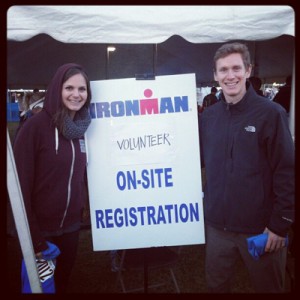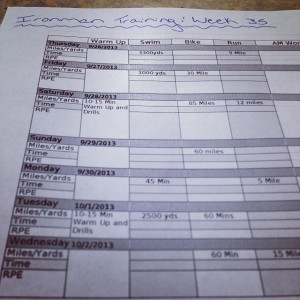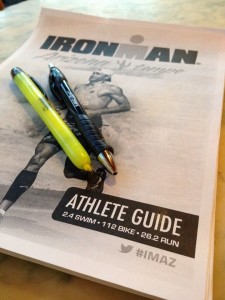I’m sitting at a coffee shop at 1:00 on a Saturday afternoon, blogging a little, studying a little less and re-familiarizing myself with what Saturday feels like. This. Is. Nice.
Funny thing, though – I’m also totally lost. I don’t know what to do with myself. Should I just go back to the gym and swim a little? As I’m sitting here thinking how I should have planned a little better for this weekend, I started to think about how much damn planning I’ve done over the last year.
There’s no question that training for an Ironman takes planning. Obviously, you’ll need to plan for smart training. But what about everything else? What about those days/weeks that you’re just not feeling well? Or what about weekends you’ll be off on a work trip? And most importantly, what about your cheat days?
Let’s take a look at all of different stages of planning that go into training for an Ironman.
Pre-training:
So, you want to do an Ironman? Congratulations, the idea of taking on such a feat is something that doesn’t even cross the majority of people’s minds. Now, how are you going to make it happen? Figure out which event you want to do, sign up to volunteer at that event the year prior to when you’d like to compete (this will get you priority registration) and then fork over the dough and sign the next year of your life away to the Ironman foundation.
If you’re anything like me, about 5 minutes after you complete the above task, the following thought will enter your mind: “how the hell am I going to get myself from struggling through a 3 mile run to swimming-biking-running 140.6 miles in the next year?”
Commence training planning. Research approaches, talk to people and decide what will work best for you. For me, it was hiring someone I already trusted to work with me through my programming for the next year. For Adam, it was following CrossFit Endurance and doing his own research to build a plan.
Training:
So, you’ve got your plan all mapped out and you know what you need to do to get to your goal. And, luckily for you, you don’t have to work, grocery shop, go to any friends’ weddings or feed the dog while you do all of this. For the next year, all you have to do is train, eat and sleep. Wouldn’t that be nice? Unfortunately, one of the hardest parts of training is organizing the rest of your life around your workouts.
Be prepared. Set your schedule ahead of time and stick to it. If you’ve never kept a calendar, this is the time to start. Plan at least a week ahead of time and know when you’re going to hit the pool, grocery store, cook dinner, etc. This is the best way to avoid stretching yourself too thin.
Recovery Days/Weeks:
Yes, these times should be used to relax and recharge, but it’s still important to plan them out so you don’t end up looking back and realizing that you fell into a slump and neglected your workouts or stretched yourself too thin making up lost time with non-training obligations like dinner dates, haircuts and errands. The last thing you want to have happen is reach the end of a recovery week and not feel recharged.
Decide what you need to accomplish during these low-intensity weeks and set realistic expectations for yourself. Remember, it’s a recovery week, so plan in time to do things that will help you recharge along with the other “life-management” type of obligations.
Cheat Day:
Plan your cheat day! If you’re keeping a clean diet (as you should be) during training, be sure to give yourself one day each week to eat whatever the hell you want. Of course, you don’t want to go overboard with these days either. Plan out what you’re going to have. There was one week recently, for example, where I had a ridiculous craving for gummy worms. So, on Sunday night that week, I devoured my weight in gummy worms for dinner. And it was glorious. Don’t waste these days on last-minute drive-thru meals. You’ve worked hard all week, so treat yourself to something that will leave you satisfied and fill the void for the next week of healthy eating. Tomorrow, I will have a pancake feast.
Race Day
I know – this one goes without saying. Planning for race day involves a lot of different aspects. Make note of everything you learn during your training sessions. These workouts are where you’ll learn what will work for you on race day. Don’t do anything new on race day – just stick with what has worked thus far. By this point, you should be operating on auto-pilot.
What about all of the other details? Have you studied the Ironman athlete guide? Do you know the check-in routine for race day? Where will you meet your spectators before/after the race? Here’s an important one: How are you getting to the race?? Start thinking about all of these smaller details at least one month ahead of time.
Get everything you need to be successful during the race situated and then focus on your spectators. These are the people who have provided so much encouragement during your training. They’ve “liked” your stupid Facebook status updates, they’ve sent you texts and emails out of the blue telling you to keep trudging through and they’re taking the time out of their weekend to come out and cheer you on. Make sure they know where you’ll be, when you’ll be there and what you’ll look like.
Recovery
How are you going to recover from the big day? Maybe a massage? Maybe you’re going to lay on the couch and catch up on that TV show everyone has been talking about but you haven’t had time to check out. Or, maybe you’re heading straight to Four Peaks to enjoy the sweet sweet taste of a Pumpkin Porter and/or (most likely and) bloody mary. Whatever it is, figure it out and keep it in the back of your mind for your final weeks of training when you’ll be tapering, the nerves will be building and you need something to look towards beyond the finish line.
Post-race Life
This is the planning stage I’m currently working on. You’ve spent the last year sticking to your schedule, knowing what’s coming the next week/day/month, working towards this one huge goal. Once you cross the finish line and spend a week celebrating with family and friends, you may return home with the feeling of a certain emptiness. “What do I do now?”
As I’m enjoying this Saturday afternoon, it’s also the first day I’ve had in months that hasn’t been filled up with training. I’ll be completely honest and say that I’m a little lost. I feel like I need to be doing more and I can only imagine how I’ll be feeling when I return to Denver, finished with my first Ironman and suddenly have all the time in the world.
It’s important to plan some post-race goals and activities to look forward to. Of course, enjoy your new low-key lifestyle, but take the necessary precautions to avoid getting yourself into a rut where you look back one, two or three months later and can only show a pyramid of empty beer cans as your greatest accomplishment.
~Live Every Day~
Cecily








